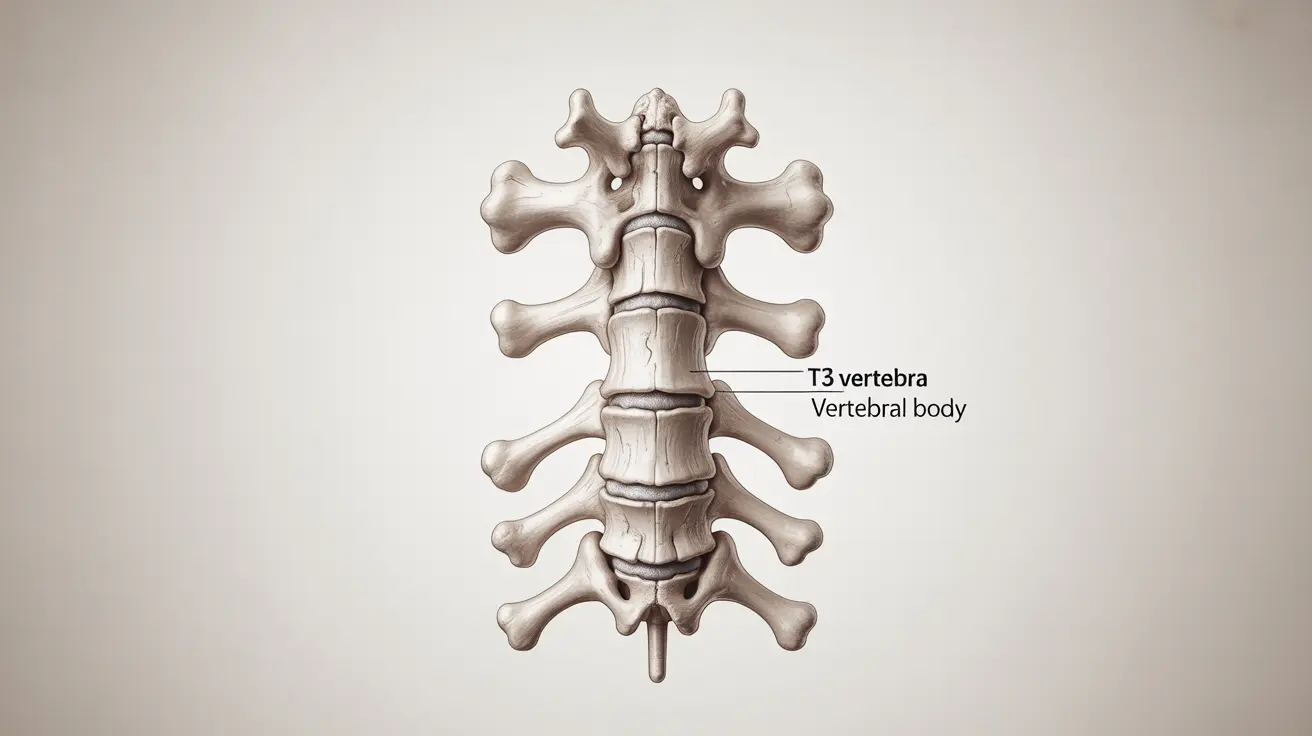The T3 vertebra, located in the upper thoracic spine, plays a crucial role in protecting vital nerve pathways and supporting proper posture and breathing mechanics. This important spinal segment connects to the ribs and serves as an anchor point for numerous muscles that help control upper body movement and respiratory function.
Understanding the T3 vertebra's anatomy and function is essential for recognizing potential problems and seeking appropriate treatment when issues arise. Let's explore this vital component of the spine in detail, including common symptoms, treatments, and preventive measures.
Anatomy and Function of the T3 Vertebra
The T3 vertebra is the third thoracic vertebra from the top of the spine. It features distinct anatomical characteristics that make it uniquely suited for its role in the upper back:
- Robust vertebral body for weight-bearing
- Specialized articulation points for rib attachment
- Protected channel for spinal cord passage
- Distinctive processes for muscle attachment
This vertebra works in conjunction with surrounding structures to maintain proper posture and facilitate breathing movements. Its position makes it particularly important for upper body stability and thoracic cage function.
Common T3 Vertebra Problems and Symptoms
Issues affecting the T3 vertebra can manifest in various ways, often impacting both local and distant areas of the body. Common symptoms include:
- Upper back pain and stiffness
- Radiating pain into the ribcage
- Breathing difficulties or discomfort
- Muscle tension in the upper back
- Referred pain in the chest area
These symptoms may vary in intensity and can significantly impact daily activities and quality of life when left untreated.
Causes and Risk Factors
Several factors can contribute to T3 vertebra problems:
- Poor posture, especially prolonged sitting
- Traumatic injuries or accidents
- Degenerative disc disease
- Occupational strain
- Sports-related stress
- Congenital spine conditions
Treatment Approaches
Treatment for T3 vertebra issues typically involves a comprehensive approach:
Conservative Management
Most T3 vertebra problems respond well to conservative treatment methods:
- Physical therapy exercises
- Postural correction techniques
- Manual therapy
- Heat and cold therapy
- Anti-inflammatory medications
Advanced Treatment Options
For more severe cases, additional interventions may be necessary:
- Spinal injections
- Advanced imaging studies
- Specialized rehabilitation programs
- Surgical intervention (in rare cases)
Prevention and Maintenance
Maintaining T3 vertebra health involves several key practices:
- Regular exercise focusing on spine mobility
- Proper ergonomics at work and home
- Good posture habits
- Core strengthening exercises
- Regular stretching routines
Frequently Asked Questions
What are the common symptoms of problems related to the T3 vertebra?
Common symptoms include upper back pain, stiffness, radiating pain into the ribcage, difficulty breathing, and muscle tension in the upper back region. Some people may also experience referred pain in the chest area or numbness and tingling in connected nerve pathways.
How does the T3 vertebra affect nerve function and breathing?
The T3 vertebra houses and protects important nerve roots that influence upper body function and breathing mechanics. It also serves as an attachment point for respiratory muscles and ribs, directly impacting breathing capacity and chest wall movement.
What causes misalignment or injury to the T3 vertebra and how can it be prevented?
Common causes include poor posture, trauma, repetitive stress, and degenerative conditions. Prevention involves maintaining good posture, regular exercise, proper lifting techniques, and workplace ergonomics.
What treatments are available for pain or dysfunction involving the T3 vertebra?
Treatment options range from conservative approaches like physical therapy, manual therapy, and medication to more advanced interventions such as spinal injections or surgery in severe cases. The appropriate treatment depends on the specific condition and its severity.
How is the T3 vertebra anatomically connected to ribs and surrounding muscles?
The T3 vertebra has specific articulation points where ribs attach through costovertebral joints. It also features various processes and surfaces where multiple muscles attach, including those involved in breathing and upper body movement.




